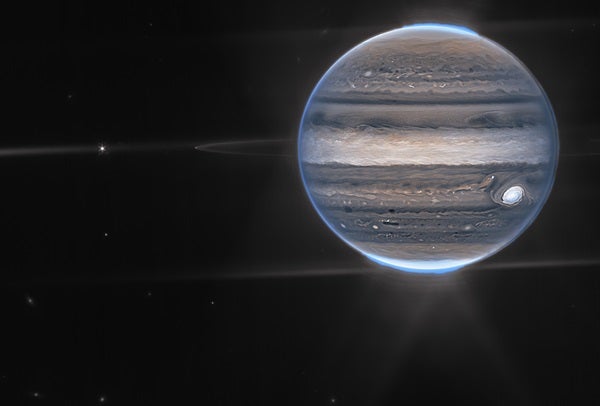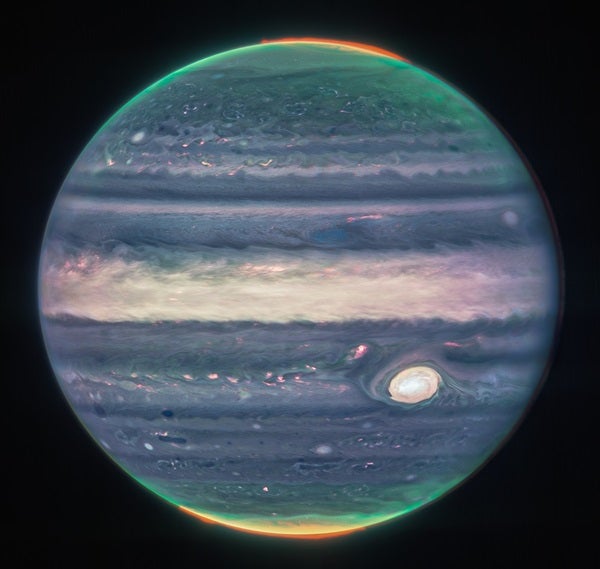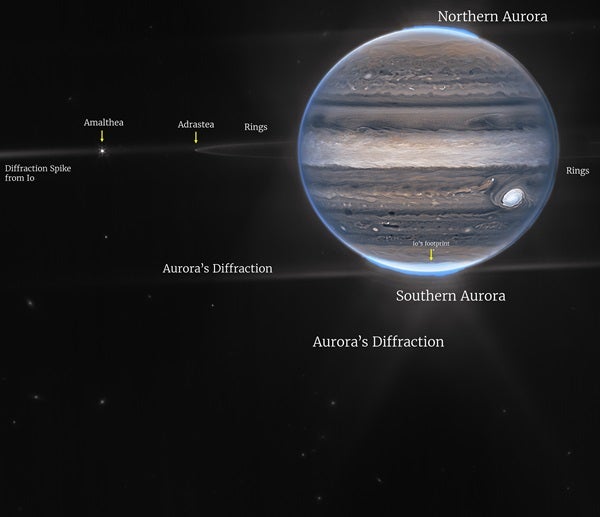When the James Webb Space Telescope (JWST) blasted off from French Guiana on Christmas Day 2021, astronomers anticipated it would deliver breathtaking images of distant galaxies and star-forming regions, as well as analyze the chemical makeups of exoplanet atmospheres. And NASA’s flagship space telescope has not disappointed.
JWST has already captured images of galaxies so far from Earth that cosmic expansion has shifted their light well into the infrared part of the spectrum, which the telescope is built to detect. And the observatory’s Near-Infrared Spectrograph (NIRSpec) has even discovered carbon dioxide in the atmosphere of exoplanet WASP-39 b — the first definitive detection of this gas in a planet beyond our solar system.
But JWST has set its sights closer to home, too. On July 27, astronomers targeted Jupiter with the telescope’s powerful infrared eyes. The resulting images reveal a planet both familiar and exotic. “We’ve never seen Jupiter like this; it’s all quite incredible,” said principal investigator Imke de Pater of the University of California, Berkeley, in a statement. “We hadn’t really expected it to be this good.”
JWST’s Near-Infrared Camera (NIRCam) captured two images of our solar system’s largest planet. In the striking close-up directly above, taken through three different filters, Jupiter displays numerous cloud bands, as well as storms and auroral emissions. The Equatorial Zone spans the planet’s girth and looks bright white because its high-altitude hazes reflect lots of sunlight. For the same reason, the massive Great Red Spot in Jupiter’s southern hemisphere shows up as a bright oval. Smaller storms across the planet appear whitish or reddish white.
The cyan hues, meanwhile, reveal clouds buried deeper in the jovian atmosphere, showing light reflected from the planet’s main cloud level at a pressure of about one bar (roughly the atmospheric pressure at Earth’s surface). The image also reveals the transition between the banded structures seen at equatorial and mid-latitude regions that earthbound observers know so well, plus more complex vortices at higher latitudes.
Jupiter’s massive auroral ovals appear as reddish glows near the giant’s north and south poles. These emissions come from ionized hydrogen atoms that extend up to 625 miles (1,000 km) above the cloud tops. The greenish areas around the poles come from hazes in the planet’s atmosphere located 60 to 120 miles (100 to 200 km) high. If you look carefully, you can trace this haze layer along the limb down to equatorial latitudes.
The spectacular wide-field view of Jupiter below combines images through two infrared filters. The jovian clouds and aurorae still stand out, but many more details appear in this composite photo. The power of JWST is exemplified by its ability to capture Jupiter’s faint and dusty rings in the same image as the bright planet itself, which shines 1 million times brighter than the rings. Also present are two faint inner moons: Amalthea (155 miles [250 km] in diameter in its longest dimension) and Adrastea (12 miles [20 km] across). Adrastea appears as a dim dot at the edge of the rings while Amalthea lies about twice as far from Jupiter’s limb.
A rich background of scattered light also permeates the image. The most obvious sources are diffraction spikes from Jupiter’s aurorae and the bright moon Io — the innermost of the planet’s four Galilean moons — which lies just beyond the lefthand edge of the image. The latter spike intersects the two visible moons. (Diffraction spikes arise in reflecting telescopes like Webb when light interacts with the struts that support its secondary mirror.) A more intriguing form of background light appears toward the bottom of this view: Scientists think the numerous fuzzy dots are actually distant galaxies that photobombed the image.
The colors in these images don’t match what the human eye would see when observing Jupiter. After all, our vision does not pick up infrared radiation. But the image processors for these stunning shots — citizen scientist Judy Schmidt and Ricardo Hueso of the University of the Basque Country in Spain — mapped longer infrared wavelengths to the red end of the visible spectrum and shorter wavelengths toward the blue, mimicking how the human eye perceives visible light. In the close-up image of Jupiter’s disk, the researchers mapped wavelengths of 3.6 micrometers to red-orange, 2.12 micrometers to yellow-green, and 1.5 micrometers to cyan. In the wide-field view showing the world’s surroundings, they mapped wavelengths of 3.35 micrometers to cyan and 2.12 micrometers to orange.
Images are just one aspect of JWST’s observing prowess; the telescope’s spectroscopic capabilities are also being brought to bear on Jupiter. On July 27, astronomers took spectra of the Great Red Spot at near-infrared wavelengths, and they carried out similar observations in the mid-infrared Aug. 14 and 15. Jupiter’s aurorae, on the other hand, will come under closer spectroscopic scrutiny later this year.
JWST scientists have high hopes for what the next-gen space telescope can teach them about the jovian system. Researchers plan to analyze the world’s cloud layers, composition, temperature, winds, and auroral activity. Astronomers also wish to better understand the structure of Jupiter’s ring system, providing insight into where it originates and how it will evolve. And finally, planetary scientists expect to create maps of the surface and atmosphere of both the volcanically active moon Io and the icy moon Ganymede. These satellite observations will also search for plumes of volcanic gases (Io) and water vapor (Ganymede).
It’s an ambitious undertaking, but if JWST’s initial observations prove anything, it’s that the telescope should be up to the task.












